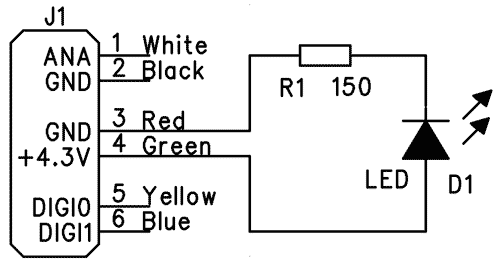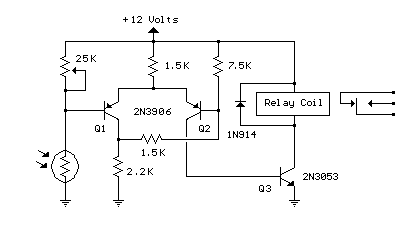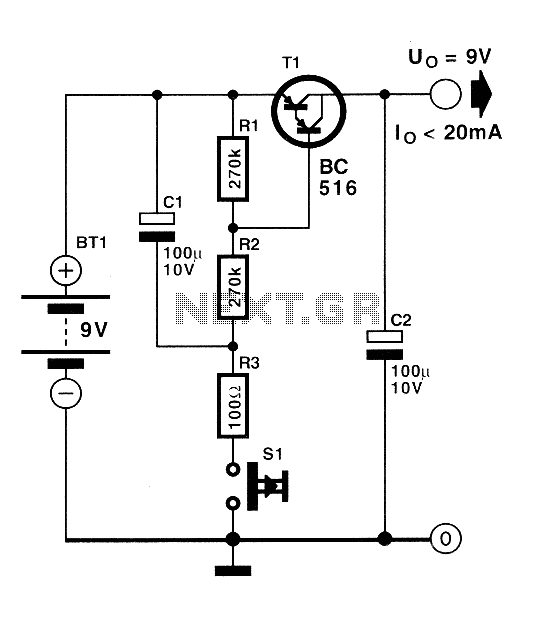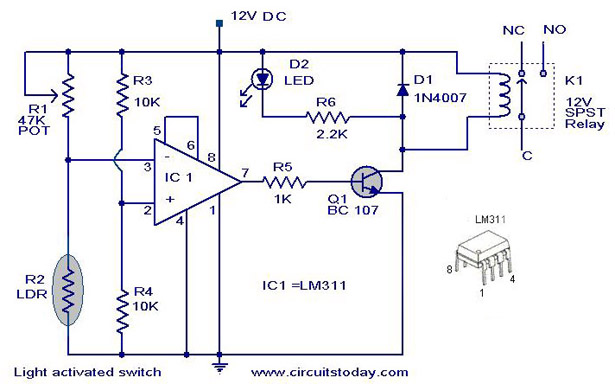
laser controlled on off switch
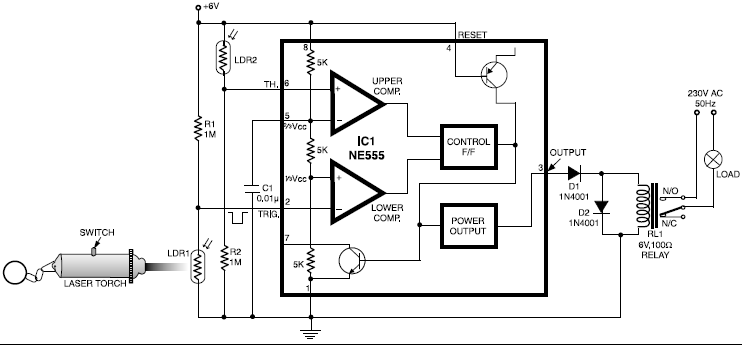
This circuit is designed around a 555 timer and utilizes a minimal number of components. Its simplicity allows even beginners to easily assemble and operate it as a control device. A readily available laser pointer can be used to activate this circuit. Testing has confirmed that it operates satisfactorily from a distance of 500 meters, with potential for effective control over even greater distances. However, aligning the laser beam precisely onto the light-dependent resistor (LDR) presents a practical challenge. This circuit is particularly useful for turning a fan on or off at night without leaving the bed and can also be employed to control various other devices, such as radios or music systems. Its functionality is limited to dark or dimly lit environments. By directing the laser beam onto LDR1, the connected device can be activated via a relay, while directing it onto LDR2 will deactivate the device.
The circuit primarily consists of a 555 timer configured in a monostable or astable mode, depending on the desired application. The LDRs serve as light sensors that detect the laser beam's presence. When the laser beam strikes LDR1, it reduces the resistance of the sensor, triggering the 555 timer to activate the relay. This relay acts as a switch, allowing a higher power device, such as a fan or audio system, to be turned on. Conversely, when the laser beam is directed at LDR2, it similarly activates the 555 timer but in a manner that resets the relay, thus turning off the connected device.
To ensure optimal performance, the circuit should be housed in a protective enclosure to prevent interference from ambient light, as the effectiveness of the LDRs diminishes in well-lit conditions. The choice of components, including the relay specifications and the values of resistors and capacitors in the 555 timer circuit, should be tailored to the specific load requirements of the devices being controlled. Power supply considerations are also essential; the circuit may be powered by a standard battery or a DC power supply, depending on the application.
In summary, this circuit offers a practical solution for remote control of various electrical devices, with significant versatility and ease of use, making it suitable for a wide range of applications in home automation and other electronic control systems.This circuit is built around a 555timer using very few components. Since the circuit is verysimple, even a novice can easily build itand use it as a controlling device. A laser pointer, now easily available in the market, can be used to operate this device. This circuit has been tested in operationalconditions from a distance of500 metres and was fou nd to work satisfactorily though it can be controlledfrom still longer distances. Aiming(aligning) the laser beam exactly on tothe LDR is a practical problem. The circuit is very useful in switchingon/off a fan at night without gettingoff the bed. It can also be used forcontrolling a variety of other deviceslike radio or music system. The limitationis that the circuit is operational only in dark or dull-lit environments. By focussing the laser beam onLDR1 the connected gadget can be activatedthrough the relay, whereas by focussinglaser beam on LDR2 we canswitch off the gadget. 🔗 External reference
The circuit primarily consists of a 555 timer configured in a monostable or astable mode, depending on the desired application. The LDRs serve as light sensors that detect the laser beam's presence. When the laser beam strikes LDR1, it reduces the resistance of the sensor, triggering the 555 timer to activate the relay. This relay acts as a switch, allowing a higher power device, such as a fan or audio system, to be turned on. Conversely, when the laser beam is directed at LDR2, it similarly activates the 555 timer but in a manner that resets the relay, thus turning off the connected device.
To ensure optimal performance, the circuit should be housed in a protective enclosure to prevent interference from ambient light, as the effectiveness of the LDRs diminishes in well-lit conditions. The choice of components, including the relay specifications and the values of resistors and capacitors in the 555 timer circuit, should be tailored to the specific load requirements of the devices being controlled. Power supply considerations are also essential; the circuit may be powered by a standard battery or a DC power supply, depending on the application.
In summary, this circuit offers a practical solution for remote control of various electrical devices, with significant versatility and ease of use, making it suitable for a wide range of applications in home automation and other electronic control systems.This circuit is built around a 555timer using very few components. Since the circuit is verysimple, even a novice can easily build itand use it as a controlling device. A laser pointer, now easily available in the market, can be used to operate this device. This circuit has been tested in operationalconditions from a distance of500 metres and was fou nd to work satisfactorily though it can be controlledfrom still longer distances. Aiming(aligning) the laser beam exactly on tothe LDR is a practical problem. The circuit is very useful in switchingon/off a fan at night without gettingoff the bed. It can also be used forcontrolling a variety of other deviceslike radio or music system. The limitationis that the circuit is operational only in dark or dull-lit environments. By focussing the laser beam onLDR1 the connected gadget can be activatedthrough the relay, whereas by focussinglaser beam on LDR2 we canswitch off the gadget. 🔗 External reference
